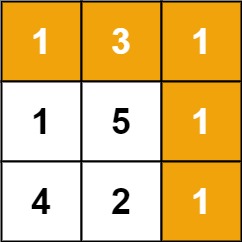Given a m x n grid filled with non-negative numbers, find a path from top left to bottom right, which minimizes the sum of all numbers along its path.
Note: You can only move either down or right at any point in time.
Example 1:
Input: grid = [[1,3,1],[1,5,1],[4,2,1]] Output: 7 Explanation: Because the path 1 → 3 → 1 → 1 → 1 minimizes the sum.
Example 2:
Input: grid = [[1,2,3],[4,5,6]] Output: 12
Constraints:
- m == grid.length
- n == grid[i].length
- 1 <= m, n <= 200
- 0 <= grid[i][j] <= 100
Runtime: 84 ms, faster than 69.24% of JavaScript online submissions for Minimum Path Sum.
Memory Usage: 41.4 MB, less than 28.83% of JavaScript online submissions for Minimum Path Sum.
/*** @param {number[][]} grid* @return {number}*/var minPathSum = function(grid) {if (grid.length === 0) {return 0;}const m = grid.length;const n = grid[0].length;const dp = Array.from({ length: m }).map(_ => Array.from({ length: n }));dp[0][0] = grid[0][0];for (let i = 1; i < m; i++) {dp[i][0] = dp[i - 1][0] + grid[i][0];}for (let j = 1; j < n; j++) {dp[0][j] = dp[0][j - 1] + grid[0][j];}for (let i = 1; i < m; i++) {for (let j = 1; j < n; j++) {dp[i][j] = Math.min(dp[i - 1][j], dp[i][j - 1]) + grid[i][j];}}return dp[m - 1][n - 1];};

